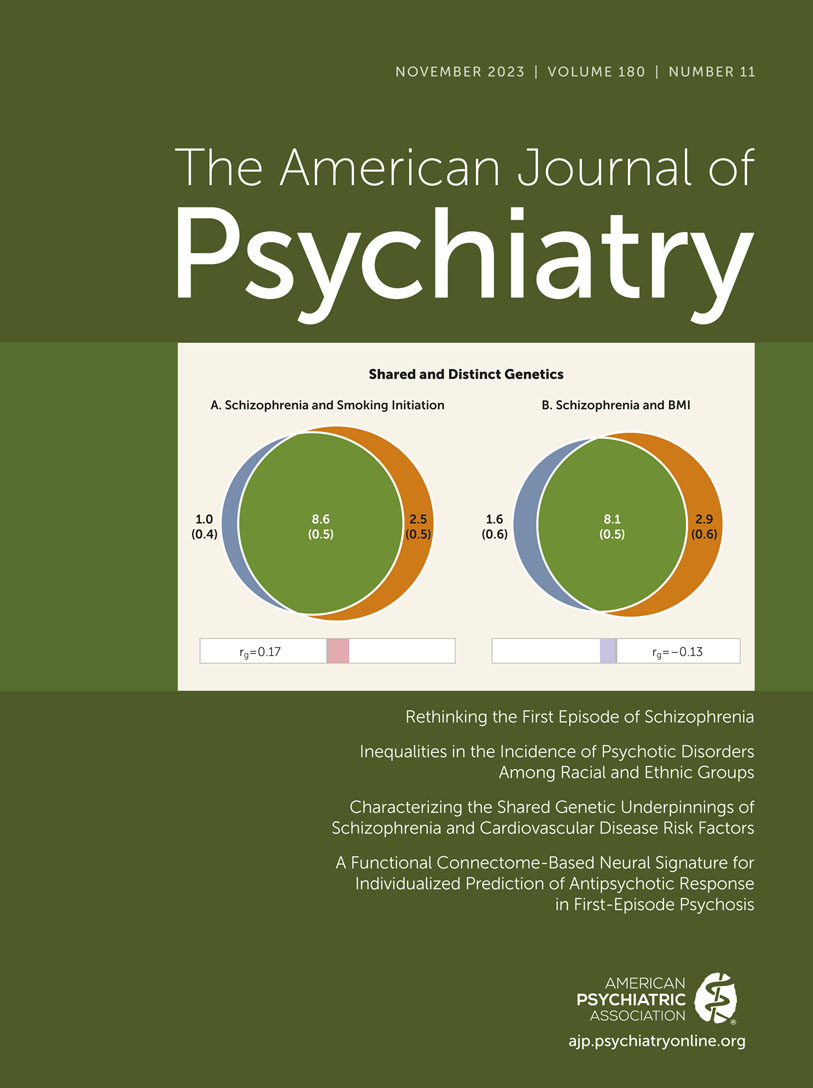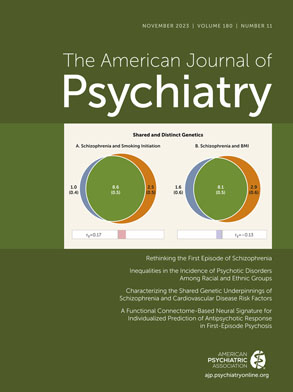Clinicians will be aware of the associations between cardiovascular disease (CVD) and schizophrenia. The challenge of treating a patient and understanding the impact psychiatric treatments may have on their physical health is all too important and is often overlooked in this stigmatized group. This is compounded by the nature of the disease itself, the symptoms of which include cognitive deficits, amotivation, and reduction of insight. These are just some of the challenges experienced on a day-to-day basis in addressing one of the more significant comorbidities in modern psychiatric practice. It is well established that individuals with schizophrenia frequently present with CVD and metabolic comorbidities, such as obesity and type 2 diabetes, and that CVD accounts for much of the observed premature mortality in this population (
1). It is noteworthy that (at least in Scotland) rates of ischemic heart disease and stroke have decreased over the past ∼30 years in the general population, but the same changes have not been observed among individuals with schizophrenia, with rates of CVD remaining stable (
1). One hypothesis that could explain this observation is that shared mechanisms underlie the pathologies of schizophrenia and CVD, and although these potential mechanisms require elucidation, there is growing evidence to support this hypothesis (
2). The article by Rødevand et al. (
3) in this issue of the
Journal sheds light on the shared genetic architecture and common biological mechanisms that contribute to both schizophrenia and CVD.
A multitude of novel approaches can be used in modern genetic studies to investigate the genetic links between schizophrenia and CVD. One method, linkage disequilibrium score regression, provides a genome-wide measure of similarity in effect sizes and directions between two traits (
4). This approach is undeniably useful for detecting a genetic architecture comprising largely consistent effects, in either the same or the opposite direction. However, if there are both positive and negative correlations across different regions of the genome, the overall correlation might appear deceptively null. Another method, the calculation of polygenic scores, also combines the sum effects of many variants, but these effects are typically aligned in one direction (e.g., trait increasing), such that the canceling out of effects in opposite directions is less of an issue.
These approaches have provided evidence for shared genetic architecture between schizophrenia and CVD or metabolic risk factors for CVD. For example, the same genetic loci have been implicated in both conditions (
5), and associations between polygenic scores for schizophrenia and glycemic control (
2,
6) and for body mass index and adipokines (
2) have been reported, with bidirectional associations also being observed (
2). In addition, the demonstration that indicators of adiposity, such as body mass index and waist-to-hip ratio, are at least partially regulated by the brain (
7,
8) suggests that considering psychiatric or behavioral traits and cardiometabolic traits as distinct is overly simplistic. However, questions still remain regarding the extent and nature of shared genetic variation between schizophrenia and CVD.
Rødevand et al. addressed these questions by applying a variety of methods, involving both genome-wide and specific locus analyses. Importantly, the genome-wide analyses included those that consider the possibility of different genomic regions having different correlations between two traits. These methods were applied to the largest available genome-wide association studies (GWASs) containing data from individuals with European ancestry. The results demonstrated many novel findings, including greater overlapping polygenicity between psychiatric traits and behavioral traits compared with that shared between psychiatric traits and cardiometabolic traits, greater overlap of schizophrenia genetic variation with behavioral traits (smoking and body mass index) than with cardiometabolic traits, and many novel loci implicated in both schizophrenia and cardiovascular and metabolic traits. These findings were validated in external data sets and highlighted mechanisms of neurodevelopment and the immune system.
Another important advance compared with previous studies exploring the genetic architecture of mental illnesses, including schizophrenia, and CVD was the authors’ approach to the major histocompatibility complex (MHC) locus. The MHC locus is a genetically highly variable and population-specific region of the genome, with sections of very long-range linkage disequilibrium. Including the MHC region in genetic analyses is problematic. The population specificity limits a researcher’s ability to validate findings in an independent population and limits the generalizability of the findings. The long-range linkage disequilibrium can also skew statistical measures because most methods assume that the variants included (for example, in a polygenic score) are independent. Hence, the MHC region is frequently omitted from studies following on from GWASs, despite this region containing the strongest association signal for schizophrenia (
9). Rødevand et al. conducted parallel analyses with and without the MHC region and demonstrated that there was little impact of this region on the candidate genes identified.
The study findings reinforce an important point for clinical consideration: the impact of genetic variants with concordant effects on schizophrenia and smoking. If the genetic variants that increase the risk of schizophrenia also increase the likelihood of smoking, this finding would suggest that smoking might be integral to schizophrenia pathology. Clinically, this could translate to individuals with schizophrenia having a very low rate of smoking cessation using willpower alone.
Smoking levels are known to be higher among individuals with schizophrenia, and smoking adds to the risk of CVD. Smoking cessation campaigns thus far have not managed to reduce smoking among individuals with schizophrenia as much as smoking has been reduced in the general population. Part of this may be due to treatment disparity (
10). Many reasons for high rates of smoking have been postulated over the years, including self-medicating for the negative and cognitive effects of the disease and minimizing the undesirable side effects of antipsychotic medication, with varying levels of evidence (
11). Indeed, there have been suggestions of a causative relationship between incident smoking and subsequent schizophrenia (
12). Trials are underway to implement best strategy approaches to reducing smoking among those with severe and enduring mental illness (
13).
The genetic architecture that increases risk of schizophrenia and reduces body mass index is curious. However, prior to the use of antipsychotic medications, weight gain was seen as an important marker for improvement in symptoms (
14). Indeed, the relationship between weight gain and improvement in psychotic symptoms continues to have some traction. This relationship opens new research avenues that include, for example, examining the roles of the gut-brain axis and specific gastric peptides. In addition, leptin, insulin, and C-peptide have been identified as potential biomarkers for predicting relapse and treatment response among individuals with schizophrenia (
15). Similarly, a neuropeptide implicated in sleep and appetite, orexin A, has been linked with reductions in negative and disorganized symptoms of schizophrenia (
16). Finally, increased levels of neuropeptide Y in cerebrospinal fluid have been linked to poorer outcomes and more severe symptoms (
17).
It must be acknowledged that although this thorough set of analyses provides a significant advance in the understanding of the relationship between schizophrenia and CVD, the generalizability of the findings to populations without European ancestry is unknown. With the increasing availability of large GWASs of individuals with diverse ancestries for a wide range of traits, we hope that this approach can be repeated in the near future to gain a more complete understanding of the shared genetic architecture of schizophrenia and CVD that reflects the global population.

